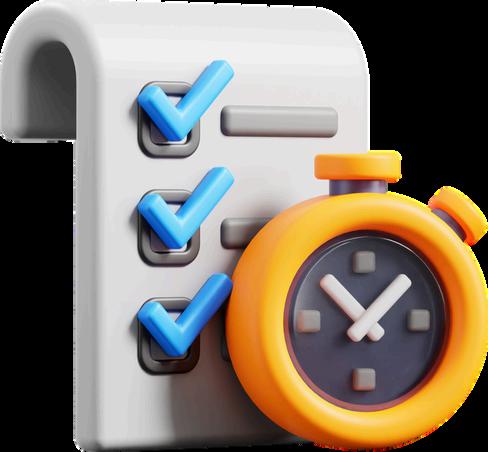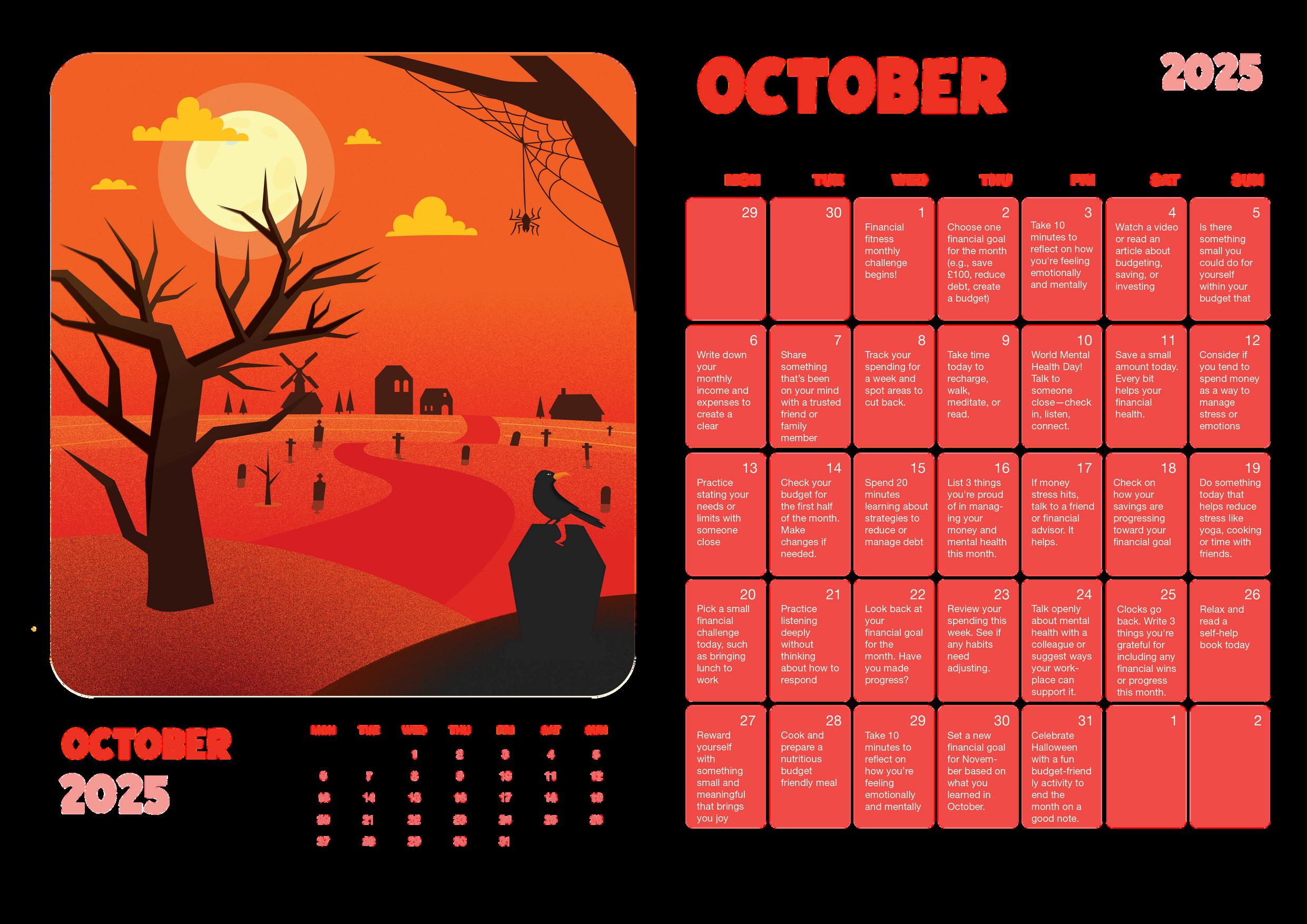















October is a month of balance As the days shorten, it’s a good time to focus on what grounds us, our health, our relationships, and the small actions that build resilience
This month brings moments to reflect and act World Mental Health Day (10 Oct) reminds us to talk openly, listen without judgement and signpost support. Later, World Menopause Day (18 Oct) brings a major life stage into the light; by raising awareness and offering flexible support, no one should feel isolated.
October is also a chance to engage more actively with the world around us Volunteering with organisations like the National Trust is a meaningful way to connect with people, nature and heritage while giving back to your community.
Wellbeing isn’t only physical or emotional, financial health matters too Our Financial Fitness Challenge offers simple, practical steps to strengthen everyday budgeting habits Small, consistent actions ease stress, build confidence and create stability for the future
And yes, keep some joy in the mix. Whether you’re carving pumpkins or sharing a small gettogether, light moments help brighten darker evenings.
This month, notice where you can restore balance, in conversations, commitments, finances or connections Small steps, repeated, change the trajectory

World Mental Health Day, observed on the 10th October each year, is a global initiative aimed at raising awareness about mental health issues and mobilising efforts to support mental wellbeing. This day provides an opportunity for all of us to reflect on the importance of mental health, reduce stigma, and promote practices that support mental wellbeing
Mental health is a crucial aspect of our overall health It affects how we think, feel, and act, influencing our ability to handle stress, relate to others, and make decisions Despite its importance, mental health often does not receive the attention it deserves. World Mental Health Day aims to change this by encouraging open conversations about mental health and advocating for better mental health services and support


This year’s theme set by the World Federation for Mental Health is access to services - mental health in catastrophes and emergencies. The theme highlights the importance of people being able to protect their mental health whatever they're going through, because everyone deserves good mental health
One of the primary goals of World Mental Health Day is to reduce the stigma associated with mental health issues Stigma can prevent individuals from seeking help and support, exacerbating their struggles By raising awareness and promoting understanding, we can create a more supportive environment where people feel comfortable discussing their mental health and seeking the help they need





There are many ways to participate in World Mental Health Day and support mental wellbeing in your community:

Learn about mental health issues and share this knowledge with friends, family, and colleagues. Understanding the signs and symptoms of mental health conditions can help you support those around you
Encourage open and honest discussions about mental health. Creating a safe space for these conversations can help reduce stigma and make it easier for people to seek help


Donate to or volunteer with organisations that provide mental health services and support Your contributions can make a significant difference in the lives of those struggling with mental health issues.
Join local or virtual events organised for World Mental Health Day. These events can include workshops, seminars, and awareness campaigns that promote mental wellbeing

Take time to focus on your own mental health. Engage in activities that bring you joy and relaxation, such as exercise, meditation, or spending time with loved ones.
Communication is how we connect, express ourselves, and share ideas, but not everyone communicates in the same way Understanding different communication styles can make conversations smoother, more fun, and even help avoid misunderstandings
Let’s dive into four common communication styles and see which one resonates with you!

2. Passive Communication: The Quiet Listener
Passive communicators tend to hold back
They might avoid expressing their own needs or opinions, often to keep the peace While they’re great at listening and absorbing information, they sometimes struggle to assert themselves If you’re the type of person who says “It’s fine” even when it’s not, you might lean towards passive communication. They’re easy-going, but sometimes their voice gets lost in the shuffle.
Assertive communicators are the gold standard of communication They’re confident, clear, and respectful of others’ opinions. When assertive people speak, they express their thoughts honestly while also listening to others. They don’t dominate a conversation, but they make sure their voice is heard Think of them as the cool, calm, and collected ones at the table. If you’ve ever told someone, “I understand how you feel, but here’s my perspective,” you’ve tapped into assertive communication!
Aggressive communicators don’t hold back. They’re direct, sometimes too direct, and can come across as domineering and intimidating These communicators may interrupt, dismiss others’ feelings, or take control of a conversation While being confident is great, aggressive communication can leave others feeling unheard. If you’ve ever found yourself thinking, “I’m always right!” then you may have some aggressive communication tendencies.
Ever received a backhanded compliment or a sarcastic remark? You’ve encountered passive-aggressive communication! This style is tricky because it’s indirect. Instead of openly expressing frustration, passive-aggressive communicators use hints or sarcasm to convey their feelings If you’ve ever said, “Oh, I didn’t realise I had to do that,” you’ve dipped into this style It can be fun in lighthearted moments but can cause confusion or frustration when misused.

No matter your communication style, being aware of it can help improve your interactions with others. You might even find yourself blending styles depending on the situation. And remember, communication is all about balance expressing yourself while respecting others So, which style do you think you use the most?
Exploring Communication Styles: Deepen Your Understanding for Effective Connection (coaching-focus.com)
Exploring the Four Communication Styles (stopavoidingyourself.com) Communication Styles Quiz: How Do You Communicate? (verywellmind.com)
Menopause is a natural biological process that marks the end of a woman’s reproductive years, typically occurring between the ages of 45 and 55 This life stage affects millions of people in the UK
While a normal part of ageing, menopause brings significant physical and emotional changes that may affect mental health Understanding these changes, and knowing how to support others, makes a real difference

Hormonal fluctuations during menopause can lead to mood swings and an increased risk of depression Women may experience feelings of sadness, hopelessness, and a lack of interest in activities they once enjoyed.
Many women report heightened anxiety during menopause This can manifest as constant worry, panic attacks, or a general sense of unease.


Some women experience cognitive changes, often referred to as “brain fog.” This can include difficulties with concentration, memory lapses, and a slower processing speed.
Insomnia and disrupted sleep are common during menopause, often exacerbating feelings of fatigue and irritability


Regular physical activity can help alleviate some of the symptoms of menopause. Exercise releases endorphins, which can improve mood and reduce stress. Aim for at least 30 minutes of moderate exercise most days of the week
Eating a balanced diet rich in fruits, vegetables, whole grains, and lean proteins can support overall health and wellbeing Certain foods, such as those high in omega-3 fatty acids, may also help improve mood


Practices such as yoga, meditation, and deep breathing exercises can help manage stress and regulate mood. There are plenty of free resources to help you get started.
Connecting with friends, family, or support groups can provide emotional support and reduce feelings of isolation Sharing experiences with others who are going through similar changes can be particularly comforting

Establishing good sleep habits can help manage sleep disturbances These include maintaining a regular sleep schedule, creating a restful sleep environment, and avoiding caffeine and electronics before bedtime
If you are experiencing severe mood swings, depression, or anxiety, it is important to seek help from a healthcare professional They can provide appropriate treatments, such as hormone replacement therapy (HRT), antidepressants, or counselling.
Conclusion
Menopause is a significant life transition that can impact mental health in various ways By understanding the potential challenges and implementing strategies to manage them, women can navigate this period with greater ease and maintain their overall wellbeing Remember, it is important to seek help when needed and to prioritise self-care during this time With the right support and resources, it is possible to thrive throughout menopause.

Boost your financial health by building better money habits over 30 days, by mastering the art of budgeting and taking control of your finances.
Effective budgeting can reduce stress, improve your overall well-being, and help you achieve your financial goals.
Track your spending
For a week, meticulously record every penny you spend. This will help you identify where your money is going.
Create a budget
Based on your spending habits, set realistic monthly budgets for essential expenses like rent, utilities, and groceries.
Prioritise your spending
Determine which expenses are essential and which can be cut back or eliminated
Find new and different ways to save
Look for opportunities to reduce costs, such as cooking at home instead of eating out or negotiating bills

Review and adjust
Regularly review your budget to ensure it's working for you. Make adjustments as needed to stay on track.

Week 1: Track Your Spending
Day 1: Start tracking every expense
Use an app, spreadsheet or a notebook to record all your purchases and bills
Day 2: Review your spending categories (food shopping, entertainment, bills, etc.).
Day 3: Set daily spending limits for non-essentials.
Day 4-7: Stick to your limits and analyse where you tend to overspend.
Week 4: Focus on Debt & Investments
Day 22: List all your debts (credit cards, loans, etc ) with interest rates
Day 23: Prioritise paying down highinterest debt
Day 24: Make an extra payment toward one of your debts, no matter how small Day 25: Learn about investment options (stocks, bonds, mutual funds, etc.).
Day 26: Consider opening a retirement account or increasing your pension contributions if you have one.
Day 27-28: Set a long-term financial goal (buying a house, early retirement, etc.) and develop a plan to achieve it.
Final Days: Reflect & Plan Ahead
Day 29: Reflect on your spending habits and financial progress this month
Day 30: Set 3 actionable financial goals for the next 6 months (e g , pay off a specific debt, save for a holiday, etc )

Week 2: Build a Budget
Day 8: List all sources of income.
Day 9: Identify your essential expenses (rent/mortgage, utilities, food, etc.).
Day 10: Subtract essential expenses from your monthly income to see what’s left.
Day 11: Allocate money for savings, investments, and optional spending.
Day 12-14: Live according to your budget and track your progress daily
Week 3: Boost Savings & Cut Costs
Day 15: Create or review an emergency fund goal (aim for 3-6 months of living expenses)
Day 16: Find one unnecessary subscription or expense to cut
Day 17: Try a no-spend day (only spend on absolute necessities)
Day 18: Look for deals or ways to save on regular purchases (food, utilities, etc )
Day 19-21: Commit to saving at least 10% of your monthly income and review how much you’ve saved.


Volunteering with the National Trust offers a rewarding opportunity to contribute to the preservation of the UK’s natural and cultural heritage. As a volunteer, you can engage in a variety of activities, such as helping to maintain historic properties, leading guided tours, or assisting with conservation projects in beautiful landscapes.
This experience not only allows you to develop new skills and meet like-minded individuals It also enables you to play a vital role in protecting the environment and promoting awareness of heritage conservation
Join the National Trust and make a meaningful difference in your community while enjoying the beauty of nature and history.


If you drive for work, you are part of one of the UK’s biggest professional communities. More than a quarter of all road deaths involve people driving as part of their job, according to the Society of Occupational Medicine That makes looking after your own wellbeing essential The good news is that small changes can make a big difference to your health.
Tiredness contributes to around 20% of all major road accidents. It is not just night shifts or long motorway journeys that cause it Early starts, irregular breaks and even dehydration can leave you less alert Planning a short stop every two hours, stepping out of the vehicle to stretch, and keeping water in easy reach all help keep you sharp. If you regularly feel drowsy during the day, speak with your GP to rule out issues such as sleep apnoea, which affects many professional drivers.
Driving for long stretches can strain your back, neck and shoulders. According to RoSPA, musculoskeletal pain is one of the most common complaints among drivers. Adjust your seat so your hips are level with or slightly higher than your knees, and keep the wheel at a comfortable distance so your elbows stay relaxed Simple stretches at rest stops can reduce stiffness and prevent long-term problems
It is easy to rely on service-station snacks, but they often give a quick sugar boost followed by a crash in energy. Packing fruit, nuts or whole-grain snacks keeps your energy more stable. Staying hydrated is just as important. Even mild dehydration can affect concentration and reaction time. A reusable water bottle in your vehicle is a simple but effective tool
Long hours alone on the road can sometimes affect mood The Society of Occupational Medicine highlights that drivers are more at risk of stress and low mood because of isolation Make a habit of calling a friend or family member during breaks, listening to podcasts, or using relaxation techniques to help maintain balance. If feelings of stress or anxiety persist, talk to your GP or occupational health service. Support is available and effective.
Looking after your health as a driver is about more than avoiding accidents. It means finishing your shift with more energy, fewer aches, and greater peace of mind. You will feel better, your family gains reassurance, and everyone on the road benefits.





Perfect for your Halloween gathering! Th features a mix of Savoury and sweet tre with some spooky decorations to set th



1 cup sliced pepperoni (or use “witches’ fingers” by cutting salami into finger shapes)
1 cup prosciutto or any cured meat, sliced
1 cup cooked sausage links, cut into bitesized pieces
1 cup cheddar cheese, cut into cubes or spooky shapes (like bats or ghosts)
1 cup brie cheese, served with a knife for spreading
1 cup mozzarella balls (for eyeballs)
Edible markers or decorative toothpicks (to create spooky faces on cheese or fruit)
Plastic spiders or creepy decorations to place on the board
1 cup black olives (for “spider eyes”)
1 cup grapes (black or purple for a spooky effect)
1 cup baby carrots (to resemble “witches’ fingers”)
1 small pumpkin or a gourd (to add a Halloween touch)
1 cup sliced apples or pears (tossed with lemon juice to prevent browning)
1 cup Halloween-themed candies (like gummy worms, candy corn, or chocolate bats)
1 cup popcorn (seasoned with spices or chocolate drizzle)
1 Choose a Board Select a large wooden board, slate platter, or serving tray as your base
2 Arrange the Meats Start by placing the sliced meats on one section of the board. You can roll some slices and create a layered look for variety.
3 Add the Cheeses Arrange the cheese cubes, brie, and mozzarella balls on the board. If using mozzarella balls, place some black olives on top to create “eyeballs” with a sprinkle of edible marker for pupils.
4. Incorporate Fruits and Vegetables. Place the baby carrots, grapes, and sliced apples or pears in various sections of the board Use the small pumpkin as a centrepiece or a decoration
5. Add Sweet Treats. Fill in spaces with Halloween-themed sweets and popcorn. Scatter gummy worms around for a creepy effect
6 Decorate the Board Use edible markers to draw spooky faces on some of the cheese or fruit. Place plastic spiders, creepy decorations, or decorative toothpicks around the board for added flair.
7 Provide small plates, napkins, and utensils for guests to help themselves

Feel free to customise the board with your favourite cheeses, meats, and snacks The key is to have a variety of textures and colours
You can add themed labels for each item (like “witches’ fingers” for baby carrots or “monster eyes” for mozzarella balls) for added fun
Arrange items in clusters for a visually appealing presentation, and don’t be afraid to let some items spill over the edge of the board for a more casual look
This Spooky Halloween Charcuterie Board is sure to impress your guests and provide a fun and delicious experience at your Halloween celebration! Enjoy!





67% of women aged 40 to 60 experiencing menopause symptoms report a negative impact on their work life.
GOV UK


1 in 4 women consider leaving their job due to menopause symptoms
Fawcett Society

30% of working women take time off due to menopause, but many don’t disclose the reason
CIPD

www.tachealthcare.com



